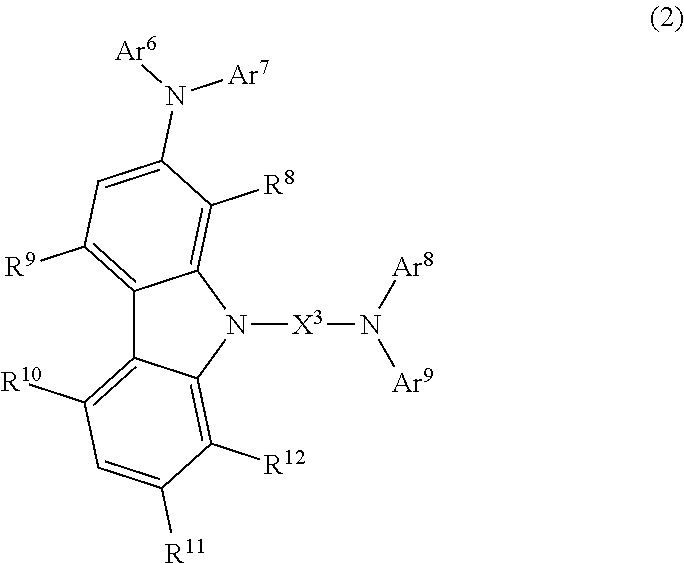Carbazole compound and use thereof
- Summary
- Abstract
- Description
- Claims
- Application Information
AI Technical Summary
Benefits of technology
Problems solved by technology
Method used
Image
Examples
synthesis example 1
[0135]Synthesis of 2-(4-chlorophenyl)nitrobenzene according to the reaction scheme (13), shown below.
[0136]In a stream of nitrogen, a 500 ml three-necked flask was charged with 25.0 g (123.0 mmol) of o-bromonitrobenzene, 21.1 g (135.3 mmol) of p-chlorophenylboric acid, 0.71 g (0.61 mmol) of tetrakis(triphenylphosphine)palladium, 100 g of tetrahydrofuran and 162 g (307.5 mmol) of an aqueous 20 weight % potassium carbonate solution, and the content was heated under reflux for 8 hours. The reaction mixture was cooled to room temperature, and separated into an aqueous phase and an organic phase. The organic phase was washed with an aqueous saturated ammonium chloride solution and then with an aqueous saturated sodium chloride solution, and then, dried over anhydrous magnesium sulfate. The dried solution was concentrated under a reduced pressure and the thus-obtained residue was purified by silica gel column chromatography using toluene as an eluent to give 27.2 g of 2-(4-chlorophenyl)ni...
synthesis example 2
[0140]Synthesis of 2-chlorocarbazole according to the reaction scheme (13), shown below.
[0141]In a stream of nitrogen, a 200 ml egg-plant flask was charged with 10.0 g (42.7 mmol) of 2-(4-chlorophenyl)nitrobenzene obtained in Synthesis Example 1, and then, 50 ml of triethyl phosphite was added. The mixture was stirred at 150° C. for 24 hours. The thus-obtained reaction mixture was distilled under a reduced pressure to remove triethyl phosphite. o-Xylene was added to the residue and then the solution was recrystallized from o-xylene give 5.1 g (25.6 mmol) of 2-chlorocarbazole as a white powder (yield: 60%).
[0142]The thus-obtained compound was identified by 1H-NMR and 13C-NMR measurements.
[0143]1H-NMR (Acetone-d6); 10.46 (br-s, 1H), 8.10 (d, 2H), 7.37-7.55 (m, 3H), 7.15-7.24 (m, 2H)
[0144]13C-NMR (Acetone-d6); 141.35, 141.15, 131.33, 126.70, 123.17, 122.64, 121.92, 120.84, 120.09, 119.78, 111.81, 111.43
synthesis example 3
Synthesis of 2-chloro-9-(4-chlorophenyl)carbazole
[0145]In a stream of nitrogen, a 50 ml three-necked flask was charged with 1.6 g (7.9 mmol) of 2-chlorocarbazole obtained in Synthesis Example 2, 1.6 g (8.7 mmol) of p-bromochlorobenzene, 1.7 g (12.2 mmol) of potassium carbonate and 10 ml of o-xylene. To the thus-obtained reaction liquid of a slurry state, 19 mg (0.08 mmol) of palladium acetate and 61 mg (0.30 mmol) of tri(tert-butyl) phosphine were added, and the mixture was stirred at 130° C. for 24 hours. The reaction mixture was cooled to room temperature, and 10 g of pure water was added thereto to separate an organic phase. The organic phase was washed with water and then with an aqueous saturated sodium chloride solution. Then the organic phase was dried over anhydrous magnesium sulfate. The dried organic phase was concentrated under a reduced pressure and the thus-obtained residue was purified by silica gel column chromatography using hexane as an eluent to give 1.6 g (5.1 mmo...
PUM
 Login to View More
Login to View More Abstract
Description
Claims
Application Information
 Login to View More
Login to View More - R&D
- Intellectual Property
- Life Sciences
- Materials
- Tech Scout
- Unparalleled Data Quality
- Higher Quality Content
- 60% Fewer Hallucinations
Browse by: Latest US Patents, China's latest patents, Technical Efficacy Thesaurus, Application Domain, Technology Topic, Popular Technical Reports.
© 2025 PatSnap. All rights reserved.Legal|Privacy policy|Modern Slavery Act Transparency Statement|Sitemap|About US| Contact US: help@patsnap.com



